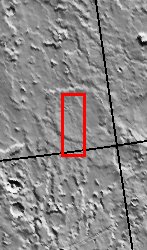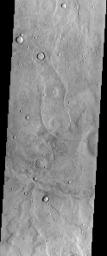
This image is from a region of Mars called Tempe Terra, which is located between the topographically high Tharsis Region and Acidalia Planitia, a large low albedo region of in the Martian northern hemisphere. This image displays a number of interesting features. There are several channels that run through the image. It is unclear if there was once lava or water running through these channels. Much of the terrain in the image appears dissected and eroded. There are a number of circular features that resemble the remnants of older craters that were mostly eroded away. The variety of the conditions of the craters indicates that this surface has been modified over a long time period. There is also a fine texture to many surfaces. This texture could also be possibly volcanic or related to ground ice.
Note: this THEMIS visual image has not been radiometrically nor geometrically calibrated for this preliminary release. An empirical correction has been performed to remove instrumental effects. A linear shift has been applied in the cross-track and down-track direction to approximate spacecraft and planetary motion. Fully calibrated and geometrically projected images will be released through the Planetary Data System in accordance with Project policies at a later time.
NASA's Jet Propulsion Laboratory manages the 2001 Mars Odyssey mission for NASA's Office of Space Science, Washington, D.C. The Thermal Emission Imaging System (THEMIS) was developed by Arizona State University, Tempe, in collaboration with Raytheon Santa Barbara Remote Sensing. The THEMIS investigation is led by Dr. Philip Christensen at Arizona State University. Lockheed Martin Astronautics, Denver, is the prime contractor for the Odyssey project, and developed and built the orbiter. Mission operations are conducted jointly from Lockheed Martin and from JPL, a division of the California Institute of Technology in Pasadena.

 Planetary Data System
Planetary Data System













